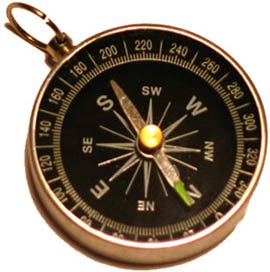Why not call the compass the north hand?
If placed anywhere, the compass needle also turns north. But Vietnamese people call it the guideline.
When we talk about an important issue with a long-term strategic meaning, we often use the guideline, for example: "A father's earnest prayer is always like a guideline for him to pass through all time. suffering ". This image is built from a familiar object in life, which is the compass.
 Compass is a device consisting of magnetic needles with two north-south poles rotating freely around an axis. Due to the influence of the earth's magnetic field, which is located anywhere parallel to the earth, the magnetic needle also turns north, from north to east, and east and west. Compass often has two opposite needles and to distinguish it, people often paint in two different colors.
Compass is a device consisting of magnetic needles with two north-south poles rotating freely around an axis. Due to the influence of the earth's magnetic field, which is located anywhere parallel to the earth, the magnetic needle also turns north, from north to east, and east and west. Compass often has two opposite needles and to distinguish it, people often paint in two different colors.
With such functions, the compass is an indispensable directional tool for those who go to the forest, go to the sea or go into a remote and desolate area easily lost. The Europeans used to use a single-needle compass, pointing north (probably by sailors, fishermen often journeying to the North Pole).But why do Vietnamese call it the guideline, not the north hand?
Compass was invented by Chinese people since the 1st century. According to Professor Nguyen Thach Giang, Chinese feudal dynasties have made full use of this feature of the compass. Troops from the Qin Dynasty until later still had the habit of expanding their territory with pacification journeys to the South. Each army had a rudimentary compass with a red painted needle. So the best generals went straight to the south to go straight ahead. In any case, the conquest only looks at that side. This is probably the main basis for making hidden semantics for the phrase "male needle" in Vietnamese.
- The compass will point 'true north' for the first time in 360 years
- How does the compass tell us where the North pole is at the South Pole?
- The oldest compass
- Discover 300-year flowers in the Arctic
- The dove has the 'compass' in the brain
- Successfully manufactured super accurate quantum compass, superior to GPS
- 18 famous inventions of ancient China
- The danger of using hand sanitizer regularly
- Special note when using hand sanitizer regularly
- The call for a mate in frogs
- The three most popular hand symbols in the world
- The question of a giant 3-finger hand can only be aliens
 'Fine laughs' - Scary and painful torture in ancient times
'Fine laughs' - Scary and painful torture in ancient times The sequence of numbers 142857 of the Egyptian pyramids is known as the strangest number in the world - Why?
The sequence of numbers 142857 of the Egyptian pyramids is known as the strangest number in the world - Why? History of the iron
History of the iron What is alum?
What is alum?